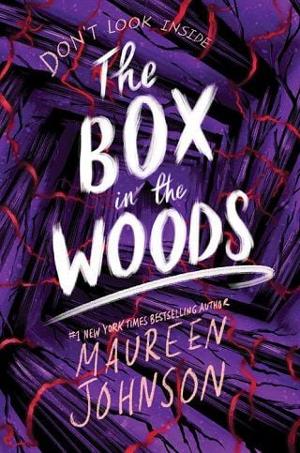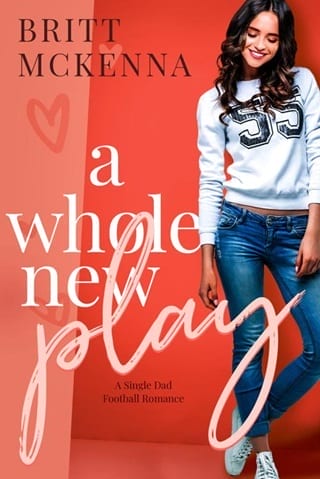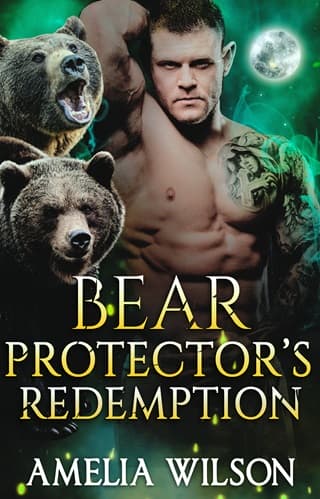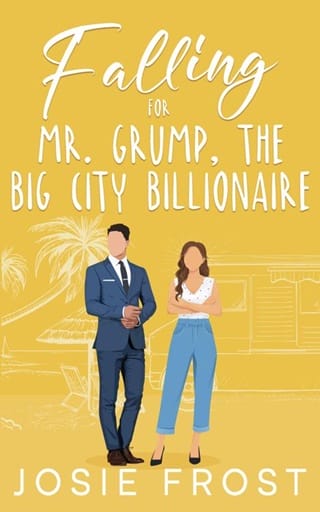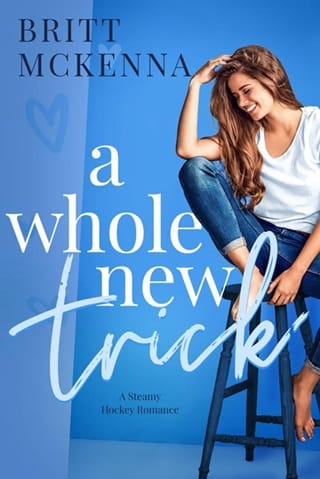Chapter 2
2
THE NEXT MORNING, STEVIE PLANTED HERSELF AT THE KITCHEN TABLEwith a bowl of cereal and an Ellingham library book that she had been permitted to take home for the summer. This was one of the many perks of Ellingham, and of being on good terms with Kyoko, the school librarian, who had specially ordered it for her.
“What’s that you’re reading?” her mother said as she passed behind Stevie. She paused, leaning in to look, as Stevie knew she would. “Is that a dollhouse?”
“Sort of,” Stevie said, flipping the page.
Her mother made a noise that sounded like a hamster being gently but persistently pressed until flattened.
The scene depicted was a kitchen lovingly crafted in miniature. The walls were papered in a cheerful pattern of deer and flowers. There was ironing on the small board, a pot in the sink, two potatoes on the draining board, each no bigger than a child’s pinkie nail. From the curtains to the line outside the window pegged with bras and stockings to the pile of folded linens, everything about this scene was made with care. This included the unmistakably dead figure on the floor by the oven, a doll-size ice tray under her hand.
“It’s called The Nutshell Studies of Unexplained Death,” Stevie said. “They’re dioramas made in the thirties and forties to teach investigators how to look at crime scenes. This one is called Kitchen. Look at the incredible level of detail. See these tiny cans on the shelves? Those labels are accurate reproductions. See the carefully printed tiny newspapers stuffed in the cracks of the doors? And all these doors have tiny, functioning keys. Everything in this scene has been made and put in here to be examined. It all means something. Did the woman stuff the paper in the door herself to gas herself? You can tell it’s gas for sure. The jets are open on the stove, and her skin has been painted so you can see the blush you get from carbon monoxide poisoning. But did she do it herself or did someone knock her out, then stuff the paper in the doors and leave her in there? See, she’s in the middle of taking things out of the oven. . . .”
Her mother stared at Stevie grimly.
“The woman who made these was named Frances Glessner Lee,” Stevie went on. “It used to be that when someone died, there was no set method for examining the body and the scene. All kinds of people would be sent who had no formal training, and they’d move things, or they’d guess at what happened, or they’d contaminate the scene. Sometimes people would be accused of murder when it was an accident and the other way around. So this woman . . .”
Stevie flipped to the photo of the grandmotherly woman with the old-fashioned glasses and bun who was peering lovingly into a skull.
“. . . was the heiress to a tractor fortune, and she was friends with the chief medical examiner in Boston. He told her about all the trouble he was having with how bodies and scenes were being treated, and all of the things you could learn about a death from the scene and the body. She basically established forensics in the United States. Then she made these miniatures, each depicting an unexplained death. Each one is a contained mystery. They still use them to train detectives.”
Her mother walked over to the counter, shaking her head. Stevie observed her surreptitiously.
“I wish you’d get another hobby, but . . .”
The sentence was left unfinished.
Stevie flipped back to the kitchen scene and let a few moments tick by while she waited for her mother to speak again.
“What are you up to this afternoon?”
“I was going to read,” Stevie said.
“It’s a gorgeous day. You could get some sun.”
Stevie hmmmmed and leaned in close to the picture of the death kitchen.
“I got a note,” she said casually, “from a guy who owns a summer camp. He read about me, what I did at Ellingham. He asked if I wanted a job working there as a counselor. I guess he thought I’d be an interesting addition, you know, something extra for campers.”
“A summer camp?” Stevie’s mom said. “You?”
“I know,” Stevie said. “Right?”
Stevie had never precisely been the outdoor type. They had camped once as a family, when Stevie was twelve and the neighbors down the street invited them to come on a week’s trip to a state park. Stevie spent most of the week huddled under their RV awning trying to read, while her parents and the other family drank iced teas and beers and talked about television shows and what was “wrong with America.” No one could swim in the lake because apparently there was some kind of brain-eating bacteria in it. Periodically someone would encourage her to walk through the woods or try out the mountain bike. Stevie viewed these offers with grave suspicion and declined. Stevie couldn’t listen to anything or talk to anyone because her parents had taken her phone in order for her to experience some “offline time,” which she had been anyway because they were in the middle of nowhere with no real signal and no Wi-Fi.
Camping sucked.
Stevie flipped to another part of the book slowly, to an even more graphic image.
“This is the most elaborate of the Nutshell Studies,” she said. “It’s called Three-Room Dwelling. Three rooms, three bodies. What’s key in this one is the blood splatter . . .”
“Where is this camp?”
“Somewhere in Massachusetts,” Stevie said. “Looks pretty, I guess. He even said I could bring my friends. Look at the blood on this blanket here . . .”
“What’s it called?”
“What?” Stevie said.
“The camp. What’s it called?”
“Oh. Um. Sunny something. Sunny . . . Oaks. Some kind of tree. Wait. I looked it up on my phone last night.”
This was a careful calculation. Her parents had probably never heard of the Camp Wonder Falls murders, and the Sunny Pines website certainly didn’t advertise the connection, but she couldn’t risk them Googling it. She had it primed and ready to go.
Her mother looked at Stevie’s phone while Stevie continued her contemplation of the blood splatter on the tiny kitchen floor.
“It looks nice,” her mother said.
It did. Stevie had examined the site in detail. It was image after image of trees, kids leaping off a platform into a lake, kids playing instruments and making crafts, bonfires, cookouts, and toasting marshmallows.
“And they said you could bring friends?” her mom asked.
“Uh-huh.”
Stevie flipped to another part of the book, to an attic scene that featured a hanging.
“And this is a real offer?” her mom said, eyeing the pictures. “From the real owner?”
“Yup.”
“Let me see it.”
Stevie blinked, as if this request was a surprise.
“Oh,” she said. “Sure. I guess.”
Stevie reached for her phone and pulled up a message, then passed it back to her mom.
Stevie,
My name is Carson Buchwald, and I am the owner and founder of Box Box (you’ve probably heard of it). I also own a summer camp in western Massachusetts called Camp Sunny Pines.
I read an article about what you did at Ellingham Academy, and I thought it was incredible. How would you like to come and work here this summer? You could be a counselor. I think it would be great to have someone like you on our staff! Our camp is in some beautiful woods. We have a swimming lake, falls, and a great little town nearby with some of the best ice cream in the country. It’s a fantastic place with great kids!
You are welcome to bring friends, if that sweetens the deal.
If you’re interested, get back in touch with me. I hope to hear from you.
Carson Buchwald
CEO and founder, Box Box
“It’s what’s inside that counts!”
“This sounds great,” her mom said. “Wouldn’t you rather do this than work in a supermarket and read books about murder dollhouses?”
“That seems like a lot of outside,” Stevie said.
“Outside is good. You could use some sun.”
“Skin cancer,” Stevie said. “Besides, I want to get a lot of reading done this summer, and there’s a free online course in forensic pathology starting in a week. . . .”
“Stevie,” her mom said. “Don’t you want to be social? Wouldn’t you like to be with your friends?”
Stevie made a show of considering this point.
“I guess,” she said after a long moment. “I’ll think about it.”
This little piece of magic had been achieved with relative ease.
She had recently been reading about Charles Manson, who used many popular persuasion techniques in order to form his murderous cult. One tip he had picked up from a popular self-help book was “Make the other guy think the idea is his.” Stevie wanted nothing to do with Charles Manson’s personal philosophy, but this passed-along tidbit was very useful and, it appeared, effective. (The only thing worse than saying “I want to go work at a murder camp” was probably “I have been studying the persuasive techniques of Charles Manson.” So this was one she was keeping to herself.)
The new email from Carson was real. She had written back to him immediately the night before.
Carson,
I am very interested. But I can promise you this—my parents are never going to let me go if they think this is about investigating a murder. Could you write another note about how this is all about camping and doing healthy outdoor stuff?
Stevie
She had no idea if he’d go for it, but it turned out he did. The squeaky-clean new email had arrived with astonishing speed. All Stevie had to do then was prop herself up with her murder dollhouse book in the morning and wait. By midafternoon, the matter was settled. Stevie Bell was going to be a camp counselor at the most notorious camp in America.
More important, she was back on a case.
 Fullepub
Fullepub 